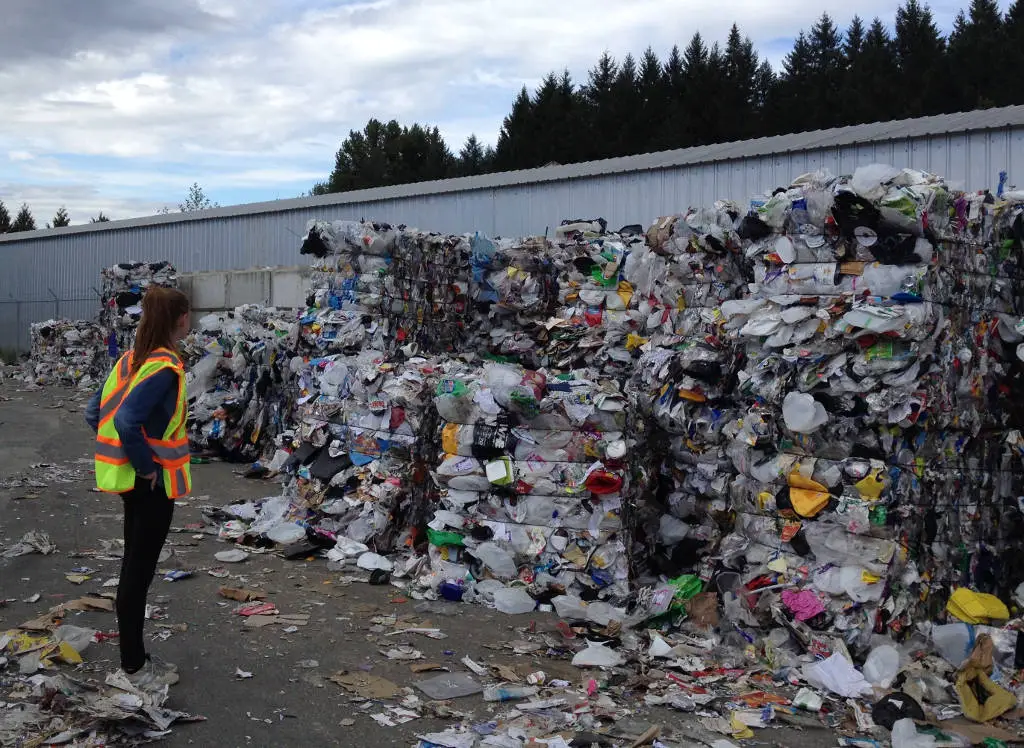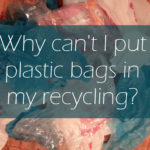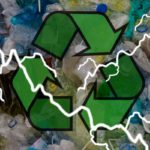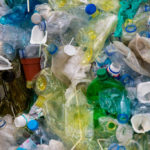Recycling at a Materials Recovery Facility – How Does It Work?

Recycling at a Materials Recovery Facility – How Does It Work?
I recently had a chance to tour a materials recovery facility or MRF (pronounced “murf”) as a part of a course I am taking to become certified as a Master Recycler through my county’s solid waste district. At a MRF, they take your recyclables that in most communities these days are all jumbled up together in your curbside bin, and sort them out to be sent to industries who use them to manufacture new materials.
How the MRF Sorting Process Works
Let me tell you, visiting the Materials Recovery Facility was an impressive and overwhelming experience to see in person. (Not to mention noisy, hot and smelly.) It’s difficult to describe exactly how all the different types of materials are separated from each other, but the short answer is that it’s a complicated system of conveyor belts, magnets, optical scanners, rotating disk screens and manual sorting by employees. For an overview of how it all works, here is an excellent video that gives a behind-the-scenes look at the entire process:
The Difficulties of Recycling Today
The entire process of sorting and recycling waste materials is pretty complicated, and has recently gotten much more difficult due to the fact that our biggest market for recycling, China, has issued much stricter rules about what they will and won’t accept. This means that while recycling used to be profitable, it isn’t any longer. A representative from Rumpke Waste and Recycling told our class that it costs $80 – $100 per ton to process recycling at a MRF. Currently, that ton of recycling is only worth $28. And 60% of what the MRF receives has no monetary value. This is a big problem.

To deal with this new reality, recycling and trash hauling services have had to raise prices. And some of the items that used to be acceptable in your recycling bin (like #5 plastic tubs), are no longer wanted because there is very little market for them.
This all means that the entire system is going to have to change. People are going to have to be re-educated about what proper recycling is, new markets are going to have to be found and/or created for recycling and reusing materials that we used to send abroad, and we’re going to have to demand better packaging processes by manufacturers so that there is a greater incentive for them to use recycled and recyclable materials.
Takeaways from Visiting a Materials Recovery Facility
In the meantime, here is what you as a responsible recycler need to know. Be sure to check with your local recycling rules, but these tips generally apply:
- Do NOT put plastic bags in your recycling! This is the biggest problem they have. Plastic bags get caught up in the rotating wheels of the disk screens and they periodically have to shut down the whole system to unclog those wheels. Every time they have to shut down, it’s costing a LOT of money in lost time. Plastic bags should be taken to someplace that accepts them, like your grocery store.
- Very small and very large plastic items should be left out. The various scanners and disk screens were created to deal with the most typical sized items, like bottles. Anything smaller than 2″ in diameter will fall through the screens, and anything bigger than a large laundry detergent bottle will be too large to fit through some of the chutes and conveyor belt stations. Our county deals with small plastics like bottle tops by asking us to put tops on bottles so they aren’t floating loose in the recycling, but some communities prefer you leave them out entirely. Check with your city or county program.
- Small pieces of paper and shredded paper should be left out too. Paper is sorted by its tendency to float to the top when bounced over the disk screens because paper is lighter than plastic, metal and glass. But this doesn’t work well with really small scraps or shredded paper. When the glass is crushed and filtered out, small pieces of paper fall through the screens and contaminate the glass. Small scraps and shredded paper should be thrown out or composted.
- When in doubt, leave it out. It may feel wrong to throw something out, but if we keep “wishcycling” and throwing in items we “hope” can be recycled, the whole system may eventually break down.
- Know that if you’re reading this article, you’re probably not the problem. All of us on the MRF tour had questions like – How clean do our recyclables need to be? What about metal lids on glass jars? What about labels? And so on. Our tour guide at the facility wanted us to know that these questions we were asking about were minor issues that will not make or break the system. Their much bigger concerns lie with the people who are throwing in items that are clearly not recyclable and contaminate whole loads and/or break their machines. (Would you believe that they commonly receive ammo, syringes, hazardous waste, road flares and even bowling balls? No kidding.)
Have more questions about what you can recycle in your community? Use the handy searchable database at Earth911 to find out how and where to recycle almost anything!




